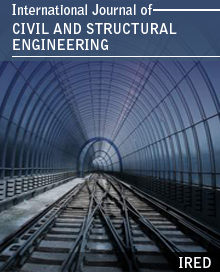Evaluation of short piles bearing capacity subjected to lateral loading in sandy soil
Author(s) : JAFAR BOLOURI BAZAZ, JAVAD KESHAVARZ
 Abstract
Abstract
Almost all types of piles are subjected to lateral loads. In many cases, however, the applied lateral loads are comparable with gravity loads. Lateral loads and moments are generally induced from wind and earthquake. All piles which are subject to lateral loads are usually divided into two categories: long piles and short piles. The general methods to estimate lateral bearing capacity of piles are based on ultimate bearing capacity and allowable horizontal displacement for short and long piles respectively. Several theoretical methods including Hansen, Broms, Petrasovits, Meyerhof, Prasad and Chari have been proposed to predict lateral bearing capacity of piles in cohesion-less soils. All these theories are based on simplified soil pressure distribution assumption along the pile length. In practice the Broms method is most popular, since it is simple and applicable for both of short and long piles. In the present research steel pipes are used as pile in laboratory to evaluate lateral capacity of piles subjected to horizontal loads. Steel model piles, with two different outside diameters of 21.7 mm and 27 mm, wall thickness of 2.4 mm and lengths of 400, 600, 800 mm were used for tests. The soil, in which piles were embedded, was fine sand with friction angle of 33о and 41.5о for loose (γ = 13.8 kN/m3) and medium dense (γ = 15 kN/m3) states respectively. The sand container was cylindrical in shape with 0.7 m diameter and 1.0 m height. Thin wires, attached to the pile at different levels, were utilized to measure horizontal displacement of piles within the soil. According to theories and experimental test results, the behavior of piles with different length and diameter, embedded in sand was evaluated. A comparison between experimental test results and different theories reveals that Prasad and Chari method is more suitable for estimation of lateral bearing capacity. It is shown that with Increasing the length and diameter of piles and also density of soil, the lateral bearing capacity increases as well, but the soil density is more effective than the other parameters. In addition, it is shown that the location of pile rotation point is not affected by changes in diameter and soil density.

About Journals
- ISSN No. : 2372-3971
- Editor Chief : Dr. Cristina Gentilini, Alma mater Studiorum - University of Bologna, Italy
- Related Subjects : Corrosion Of Reinforcement In HVFA Concrete, Advanced Construction Materials : Microsilica In Concrete, Oceans as a Non-conventional Source of Energy, Silica Fume Concrete
 Full Paper PDF
Full Paper PDF